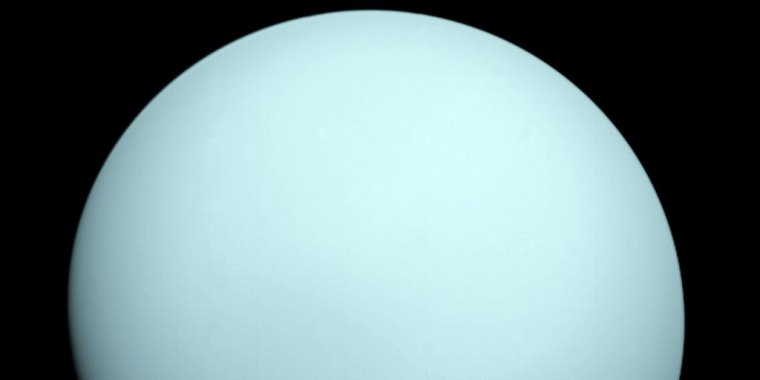| News / Science News |
The ice giant Uranus appears to be losing a bit of its atmosphere to space
The ice giant Uranus appears to be losing a bit of its atmosphere to space, perhaps siphoned away by the planet's magnetic field.

This is an image of the planet Uranus taken by the spacecraft Voyager 2 in 1986. Photo: NASA
Eight and a half years into its grand tour of the solar system, NASA's Voyager 2 spacecraft was ready for another encounter. It was Jan. 24, 1986, and soon it would meet the mysterious seventh planet, icy-cold Uranus.
Over the next few hours, Voyager 2 flew within 50,600 miles (81,433 kilometers) of Uranus' cloud tops, collecting data that revealed two new rings, 11 new moons and temperatures below minus 353 degrees Fahrenheit (minus 214 degrees Celsius). The dataset is still the only up-close measurements we have ever made of the planet.
Three decades later, scientists reinspecting that data found one more secret.
Unbeknownst to the entire space physics community, 34 years ago Voyager 2 flew through a plasmoid, a giant magnetic bubble that may have been whisking Uranus' atmosphere out to space. The finding, reported in Geophysical Research Letters, raises new questions about the planet's one-of-a-kind magnetic environment.
Planetary atmospheres all over the solar system are leaking into space. Hydrogen springs from Venus to join the solar wind, the continuous stream of particles escaping the Sun. Jupiter and Saturn eject globs of their electrically-charged air. Even Earth's atmosphere leaks. (Don't worry, it will stick around for another billion years or so.)
The effects are tiny on human timescales, but given long enough, atmospheric escape can fundamentally alter a planet's fate. For a case in point, look at Mars.
"Mars used to be a wet planet with a thick atmosphere," said Gina DiBraccio, space physicist at NASA's Goddard Space Flight Center and project scientist for the Mars Atmosphere and Volatile Evolution, or MAVEN mission. "It evolved over time" - 4 billion years of leakage to space - "to become the dry planet we see today."
Atmospheric escape is driven by a planet's magnetic field, which can both help and hinder the process. Scientists believe magnetic fields can protect a planet, fending off the atmosphere-stripping blasts of the solar wind. But they can also create opportunities for escape, like the giant globs cut loose from Saturn and Jupiter when magnetic field lines become tangled. Either way, to understand how atmospheres change, scientists pay close attention to magnetism.
Unlike any other planet in our solar system, Uranus spins almost perfectly on its side completing a barrel roll once every 17 hours. Its magnetic field axis points 60 degrees away from that spin axis, so as the planet spins, its magnetosphere - the space carved out by its magnetic field - wobbles like a poorly thrown football. Scientists still don't know how to model it.
Little known at the time of Voyager 2's flyby, plasmoids have since become recognized as an important way planets lose mass. These giant bubbles of plasma, or electrified gas, pinch off from the end of a planet's magnetotail - the part of its magnetic field blown back by the Sun like a windsock. With enough time, escaping plasmoids can drain the ions from a planet's atmosphere, fundamentally changing its composition.
Comparing the results to plasmoids observed at Jupiter, Saturn and Mercury, scientists estimated a cylindrical shape at least 127,000 miles (204,000 kilometers) long, and up to roughly 250,000 miles (400,000 kilometers) across. Like all planetary plasmoids, it was full of charged particles - mostly ionized hydrogen. (NASA)
YOU MAY ALSO LIKE





